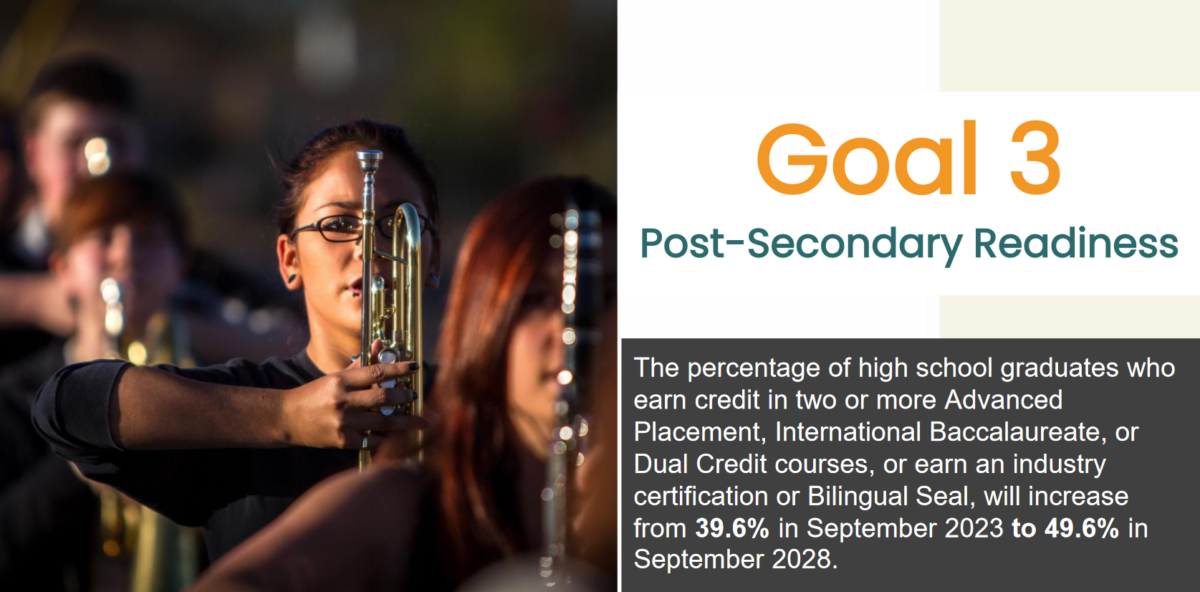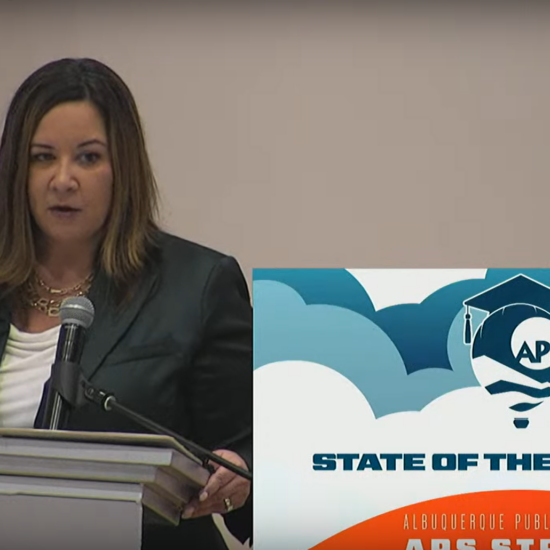
The Albuquerque Public Schools (APS) Board of Education recently reviewed the district’s progress toward its strategic goals focused on enhancing post-secondary readiness among high school students. This review aligns with APS’s commitment to monitoring and improving student outcomes as part of their broader strategic plan.
Monitoring Framework and Outcomes
As part of their Emerging Stronger plan, the district is routinely reviewing progress for each of the four goals outlined in the strategic plan. So far, the district has reviewed progress toward their literacy goals, their math goals, and how much time they spend in their meetings addressing student outcomes.
Goal 3 is ambitious:
The percentage of high school graduates who earn credit in two or more Advanced Placement, International Baccalaureate, or Dual Credit courses, or earn an industry certification or Bilingual Seal, will increase from 39.6 percent in September 2023 to 49.6 percent in September 2028.
Annual Targets for Goal 3:
- 2024: 40.6 percent
- 2025: 41.6 percent
- 2026: 43.6 percent
- 2027: 45.6 percent
- 2028: 49.6 percent
The board assessed three key interim goals during their April 2024 meeting, emphasizing different aspects of post-secondary readiness. Each goal is part of a strategic initiative to improve student performance and readiness for post-secondary education and career opportunities by 2026.
“We are committed to rigorously monitoring our progress towards these ambitious goals to ensure that we are making the necessary adjustments and achieving the desired outcomes for all of our students,” said Incoming Superintendent Gabriella Duran Blakey.
Goal 3.1: Reducing Drop-Out Rates
The first interim goal for APS is centered on significantly reducing the high school dropout rate from 4.2 percent in May 2023 to 3.2 percent by May 2026.
Recent data, however, shows a concerning uptick in dropout rates. APS has conducted an analysis to identify several systemic root causes behind this increase, pinpointing issues such as low student engagement and the challenging transitions students face when moving from middle to high school.
The APS Interim Goal 3.1:
The percentage of high school students who drop out of school will decrease from 4.2 percent in May 2023 to 3.2 percent in May 2026.
Annual Targets for Interim Goal 3.1:
- 2024: 3.8 percent
- 2025: 3.6 percent
- 2026: 3.2 percent
To combat these trends, APS is taking proactive measures to bolster student retention.
“We are implementing targeted support systems tailored specifically for incoming ninth graders and introducing early intervention strategies to identify and assist at-risk students before they fall too far behind,” explained Dr. Antonio Gonzales, APS Chief Academic Officer. “Our approach includes a comprehensive district-wide credit recovery strategy aimed at keeping students on track to graduate, thereby reducing our dropout rates.”
Goal 3.2: Enhancing Course Enrollment
The second interim goal focuses on increasing the enrollment of high school students in advanced coursework. These include Advanced Placement (AP), International Baccalaureate (IB), dual credit courses, and career pathway programs. The specific target set by APS is to elevate enrollment from 48.3 percent in May 2023 to 54.3 percent by May 2026.
Recent figures from Fall 2023 show signs of progress, with enrollment in these courses ticking up to 48.4 percent, reflecting a steady increase over previous years. APS credits this upward trend to several key strategies that have been implemented district wide.
“We have revamped our course catalogs to make them more comprehensive and accessible, which allows students and their families to make informed decisions about their educational paths,” Gonzales said. “Additionally, we’ve enhanced our student engagement strategies and expanded opportunities for work-based learning, which have both contributed to the increased interest and participation in these advanced courses.”
APS Interim Goal 3.2:
The percentage of high school students enrolled in Advanced Placement, International Baccalaureate, or dual credit courses, second-year or higher language courses, or a career pathway concentrator course will increase from 48.3 percent in May 2023 to 54.3 percent in May 2026.
Annual Targets for Interim Goal 3.2:
- 2024: 49.3 percent
- 2025: 51.3 percent
- 2026: 54.3 percent
These initiatives are part of APS’s broader efforts to provide students with valuable academic and practical experiences that align with college and career readiness standards.
Goal 3.3: Boosting Credit Attainment
APS has set an ambitious target to increase credit attainment among 11th graders in advanced coursework. The objective is to raise the percentage from 58 percent in May 2023 to 64 percent by May 2026. As of Fall 2023, preliminary data indicates that 57.4 percent of 11th graders have earned credits in these courses.
This improvement in credit attainment is driven by a series of targeted initiatives aimed at enhancing the educational experience for high school students. According to Gonzales, the district has been developing career pathways that not only engage and interest students but also provide them with practical skills and knowledge applicable to future job markets.
APS Interim Goal 3.3:
The percentage of grade 11 students who earned credit in at least one Advanced Placement, International Baccalaureate, dual credit, third-year or higher language course, or a career pathway completer course will increase from 58 percent in May 2023 to 64 percent in May 2026.
Annual Targets for Interim Goal 3.3:
- 2024: 59 percent
- 2025: 61 percent
- 2026: 64 percent
In addition to curriculum alignment and career pathway development, APS has strengthened its student support systems across all high schools. “Our focus has been on creating a supportive learning environment that caters to the diverse needs of our students,” explained Gonzales. “This includes providing personalized guidance and academic support to help students navigate through their courses successfully and earn the necessary credits.”
Challenges and Strategic Adjustments
Despite these advancements, APS faces ongoing challenges, particularly in maintaining consistent student engagement across all demographic groups and ensuring equitable access to advanced educational opportunities.
“To meet these challenges head-on, we are enhancing our support systems and deploying targeted interventions designed to elevate student engagement and achievement. By focusing on data-driven strategies and inclusive educational practices, we aim to ensure that all students have the tools they need to succeed,” Gonzales told the board.







